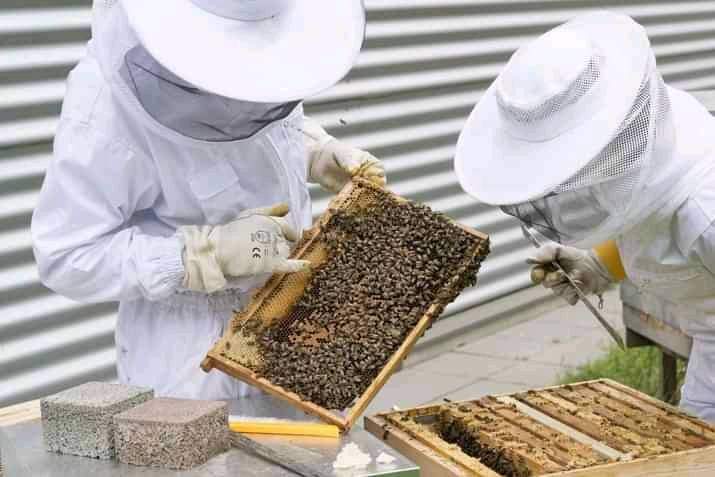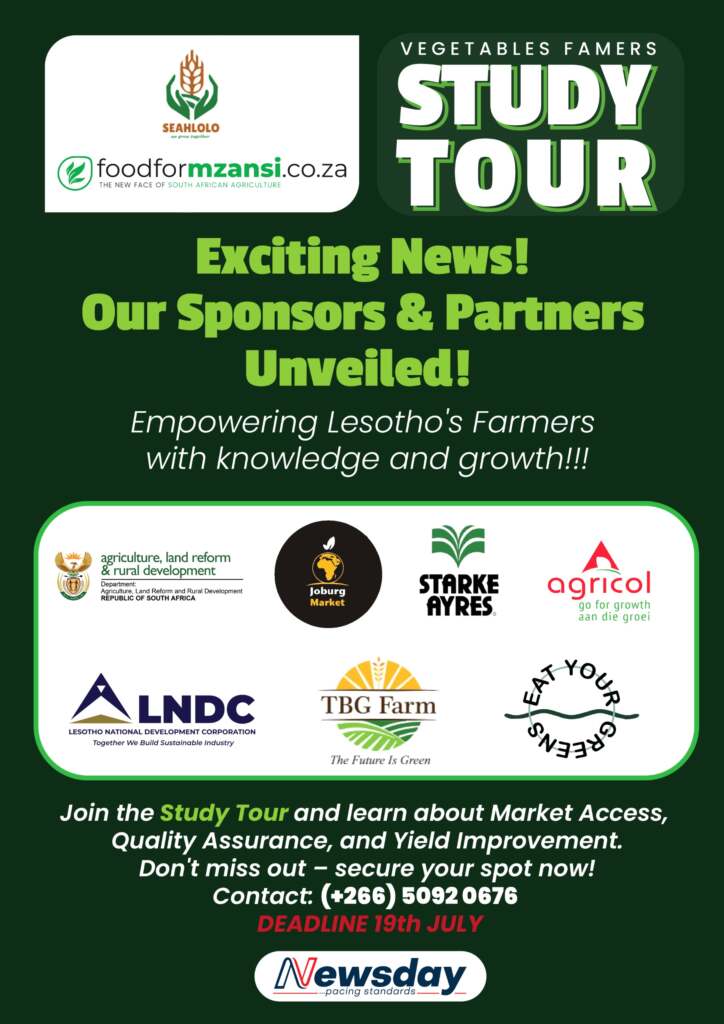The early morning shock when a swamp of bees enveloped ‘Mamoitsepi Letsie’s (ML) household was the starting point of a journey of honey production and reaping profits.
The beneficiary of the Global Environment Facility (GEF) Small Grants Programme (SGP) of the United Nations Development Programme, Letsie who hails from Pulane in the Berea district, is a walking encyclopaedia of knowledge and skill.
The focus of the project in Lesotho includes building the capacity of women in beekeeping, removing the barriers to upscaling beekeeping and the production of honey and other hive products to sustain the livelihood of farmers, especially women and youth who reside in areas with potential for apiculture (beekeeping).
Bees are part of the biodiversity on which animals and crops depend for survival. They provide high-quality honey food, pollen and other bee-related products such as beeswax, propolis and honey bee venom, but for Letsie, beekeeping provides an important source of income.
The well-achieved farmer reminisces on her journey and how she keeps winning, not only financially, but being awarded accolades for her work.
In this extensive interview with Seahlolo’s journalist Kabelo Masoabi, Letsie shares her ups and downs and opportunities since starting Manganganeng Beekeeping Farm in 2012.
*Manganganeng Beekeeping Farm won a M5000 voucher during the Farmers Pitso Awards 2023, credited for being the best beekeepers.
Seahlolo: How did you venture into the apiculture agribusiness?
ML: One morning a few years ago, a swarm of bees settled in my compound. Out of frustration, I approached the Ministry of Agriculture for tips on how to drive them away but they enlightened me that I could turn that situation into a fortune.
The officer advised me on different techniques I needed and directed me to where I get more help.
I then signed up for a beekeeping training and eventually, I fell in love with the bees.
I learnt that beekeeping doesn’t require large areas of productive land, that it has low labour intensity, and needs low start-up costs with a high return on investment. In addition, bees provide pollination services resulting in improved productivity and profitability of small-holder farms.
Seahlolo: What techniques did you use to end up keeping a swarm of bees as your startup product?
ML: I started by collecting a few pieces of equipment needed. Apart from a hive and frames to fit, you need protective gear and some specialist tools like a smoker and pollen trap that are also essential to help you manage your colony.
A bee suit, along with a hat, gloves and boots covers you from head to toe to protect you from bee stings. Although bees aren’t generally aggressive, they can sting when disturbed.
A smoker helps keep your bees calm and docile while you work. With an efficient modern smoker, it’s easy to gently puff smoke over your bees while you are working, reducing your chances of being stung.
Seahlolo: Can you describe apiculture as a sustainable business?
ML: Even a beginner backyard beekeeper can make money from beekeeping. There are a lot of ways you can generate income as a beekeeper. You can sell the products you harvest from the hive, you can sell your beekeeping skills. Some people make so much money from beekeeping that it becomes their full-time career. I’m content with the profits I make.
Seahlolo: How many top bar hives and trap boxes did you begin with and how many do you have at present? How often do you harvest and what do you harvest the most?
ML: When I started in 2012 I had two hives and two trap boxes. Now I own 30 hives and 5 trap boxes.
We harvest four times a year and mostly it is honey, which is the basic ingredient in making many of my products.
Seahlolo: Which of the beekeeping products yields more money?
ML: Honey is typically the first thing people think of when it comes to bee products, however, it’s not the only one.
There are many products we sell and make a profit, but there is no denying that selling honey is one of the biggest ways you can make money as a beekeeper.
Honey production costs are low, and it is one product with the highest demand many people also prefer their local honey to be raw and organic and that’s our selling point.
Seahlolo: What other bee products do you sell?
ML: Organic beeswax is another popular bee product we produce and process to make other products including Vaseline, lip balms, soap made with honey and goat milk.
Seahlolo: There is a component called propolis, what is it used for?
ML: Propolis is a sticky plant substance that bees use to disinfect and maintain their hives. It can help people battling diabetes, cold sores, and swelling or sores inside the mouth. Propolis is also said to help in the case of burns, genital herpes and other conditions our propolis medicine helped a lot of patients during the outbreak of Covid-19. (There is no credible scientific evidence to back these claims).
Seahlolo: How many employees does the farm have, and in monetary terms, how much does the farm make in a month?
ML: A small-scale beekeeping farm like mine is not labour-demanding, so it is currently run by three family members and a varying number of part-time workers employed for certain periodical jobs.
The monthly profit evolves around M5,000. It’s growing steadily as more and more people are becoming aware of the benefits of the products. I’m engaged in intensive advertising which is critical in providing the education needed.
Seahlolo: How long did it take you to confidently say the farm is now a lucrative business?
ML: I would say about 8 years. It’s been a long journey for someone who didn’t know anything about the industry, but it’s worth it.
Seahlolo: What are the eminent challenges of production? How did you win against the challenges?
ML: I can talk about challenges that influence their growth, reproduction, and sustainability, particularly climate change, pesticides, and management strength. All these are manageable through obtaining proper information and applying it. You have to connect yourself with the bees so that you can quickly notice if something is wrong. Then act appropriately to address the problem on time.
Seahlolo: Bees are known to be dangerous insects. How do you manage them?
ML: The good thing about bee-keeping is that it is one of the cheapest forms of business and I enjoy the benefits of owning them. Unlike other animals, you need not drop even a small sweat looking after them. They look after themselves, they take themselves out to look for flowers and come back home without your involvement. Always be cautious not to scare them, they fight back when irritated. Another advantage of keeping bees is that they cannot be stolen.
Seahlolo: What type of technologies did you learn from the GEF SGP project currently helping you sustain your apiculture?
ML: I have been exposed to new beekeeping technologies and this has had a positive impact on my produce. The focus of trainings is basically on how to make our top bar hive which helps with limiting our expenditure. Have acquired lessons on hive, disease and pest management and business management.
Seahlolo: How else do benefit from the knowledge you have acquired as a veteran beekeeper?
ML: When you have been beekeeping for a while, you can use your experience and knowledge to help teach others. I offer classes to people who aspire to become beekeepers. Currently, I’m grooming my daughter aged 19, so that she can take over the family business.
Seahlolo: There is a general problem of post-harvest loss in Lesotho, do you ever experience loss? If yes, what kind of loss? If not, how do you manage your handling after your harvesting?
ML: Honestly speaking I don’t experience postharvest losses because I apply effective management of post-harvest losses. Honey and bee products require a combination of proper harvesting techniques, efficient extraction and processing, adequate storage and packaging, pest and disease management, and market development strategies. By implementing these measures, you can minimise losses, maintain product quality, and maximize profits in the honey and bee products industry.
Seahlolo: While other farmers are concerned about the current drought, are you worried?
ML: Definitely. Extreme heat and drought have always been great enemies of bees. In summer the hives get hot, the bees struggle to cool their house and the beekeepers have to intervene much more frequently.
As a beekeeper, you should provide bees with a reliable water source in hot weather. Other ways to help keep the colony cool include positioning hives in partial shade, adding insulation, and ensuring adequate ventilation.
Seahlolo: Does climate change affect apiculture? If yes how, and what are mitigation measures?
ML: Most crops grown globally require pollination to produce food, and honey bees are the most important pollinators. Without honey bees, the food supply would decrease and become more expensive. Climate change threatens honey bees by destroying their habitats and food sources. Uncontrolled fires also wreak havoc in beekeeping. Therefore, beekeepers must implement farm management practices to adapt to climate change.
To adapt, beekeepers reinforce their beehive boxes, relocate their beehives from extreme temperatures, and supplement the honey bees’ food, among other possible mitigation measures.




